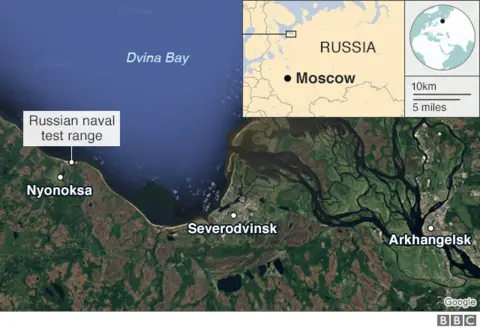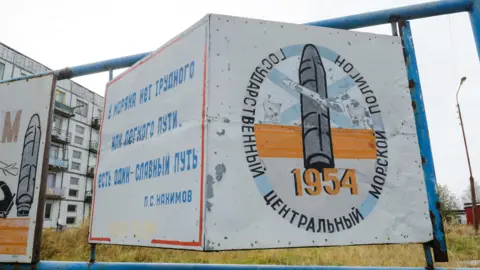Rocket mystery: What weapon was Russia testing in Arctic?
Five Russian nuclear engineers who died in a rocket engine explosion have been buried in Sarov, a closed town 373km (232 miles) east of Moscow, where nuclear warheads are made.
The Russian state nuclear agency, Rosatom, said the experts had been testing a nuclear-powered engine. But it gave no further technical details.
The test was on an offshore platform in the Arctic, at a naval test range.
Russia has previously tested a nuclear-powered cruise missile, "Burevestnik".
But officials did not specify the system involved in Thursday's disastrous test.
The explosion was followed by a 40-minute radiation spike in Severodvinsk, a city 40km (25 miles) east of the Nyonoksa test range, by the White Sea.
Severodvinsk officials said radiation in the city reached 2 microsieverts per hour, then fell back to the normal 0.11 microsieverts. Both levels are too small to cause radiation sickness.
Three other engineers were injured in the blast, and are now in hospital, Rosatom said.

Experts in Russia and the West say the test was most likely linked to the 9M730 Burevestnik, meaning "petrel", a type of seabird. President Vladimir Putin described the missile in a speech to the Russian parliament in March 2018. Nato has given it the designation SSC-X-9 Skyfall.
Prof Mark Galeotti, a leading Russia analyst and researcher at the Royal United Services Institute (Rusi), says nuclear propulsion poses huge technical challenges. "There is speed versus the weight of the system, and the risk of a missile that spews radioactive exhaust wherever it goes," he told the BBC.
"These new systems have their origin in Soviet times - they've been taken off the shelves and given new investment."
The Burevestnik's nuclear propulsion would, according to Mr Putin, give it "unlimited" range. But the Nyonoksa explosion could have involved a different weapon, equally capable of delivering a nuclear warhead:
- a new long-range, anti-ship cruise missile called Zircon, which is hypersonic - it can fly at up to eight times the speed of sound, the Russian military says
- a new long-range underwater drone, launched from a submarine, called Poseidon
What is known about the explosion?
The five nuclear engineers who died were "elite" experts and "heroes" who knew the risks and had conducted previous tests in "extraordinarily tough conditions", senior Rosatom official Valentin Kostyukov said.
He heads the Sarov nuclear centre - a secret Cold War-era facility responsible for Russia's hydrogen bomb arsenal.
He named the five as: Alexei Vyushin (a designer and software specialist); Yevgeny Korotayev (senior electrical engineer); Vyacheslav Lipshev (head of the scientific testing team); Sergei Pichugin (testing engineer); Vladislav Yanovsky (deputy head of the scientific testing department).
At the funeral, Rosatom chief Alexei Likhachev said "the best way to remember them is to continue our work on new types of weapon, which will be completed without fail".
Initially the defence ministry said the explosion on 8 August had involved a liquid-fuel rocket engine, and gave the death toll as two, without specifying the victims.
Later, Rosatom said the test had involved a "radio-isotope propellant source" and had taken place on an offshore platform.
The engineers had completed testing, but suddenly a fire broke out and the engine exploded, throwing the men into the sea, Rosatom said.
Soon after the blast the Severodvinsk administration reported a 40-minute spike in radiation in the city, and news of that prompted locals to buy up stocks of iodine in the city's pharmacies.
Iodine pills offer some protection from radioactive iodine - and there was a huge demand for them during the 1986 Chernobyl disaster.
 Reuters
ReutersAhead of the test, the defence ministry imposed an exclusion zone in Dvina Bay - the waters north of the Nyonoksa test range. The zone will remain closed to civilian shipping until early September.
A Norwegian Arctic news website, the Barents Observer, reported that a Russian specialised nuclear cargo ship, the Serebryanka, was inside the exclusion zone on 9 August.
There is speculation that the ship was deployed to pick up any radioactive debris in the event of a failed test, and may be doing just that now.
But the closed zone may also be a precaution against any escape of toxic rocket fuel into the water, where locals go fishing.
Is the nuclear-powered missile a game-changer?
Rusi's Mark Galeotti says "there is a lot of scepticism about whether the Burevestnik will ever see the light of day".
He notes that another state-of-the-art Russian missile, the Bulava, "had many years of failed tests".
The Zircon and Poseidon missiles are more advanced projects. The Poseidon underwater drone already exists in prototype.
But Poseidon, like the Burevestnik, appears to be an "apocalyptic" weapon, Mr Galeotti says - impractical for anything short of all-out nuclear war.
 AFP
AFPRussia's government newspaper Rossiiskaya Gazeta last month described Burevestnik as "a vengeance weapon". That was also the phrase used by the Nazis to describe their V-rockets, fired at the UK late in World War Two.
The newspaper said Burevestnik - capable of long-duration flight and avoiding air defences - would target any remaining vital infrastructure after Russia's intercontinental ballistic missiles had already struck enemy territory.
With the recent collapse of the Intermediate-Range Nuclear Forces (INF) treaty, the US will now focus more on "developing the intermediate-range arsenal, something short of all-out war", Mr Galeotti said.
"The Russian military also want that capability, because they are also worried about China," he added.
